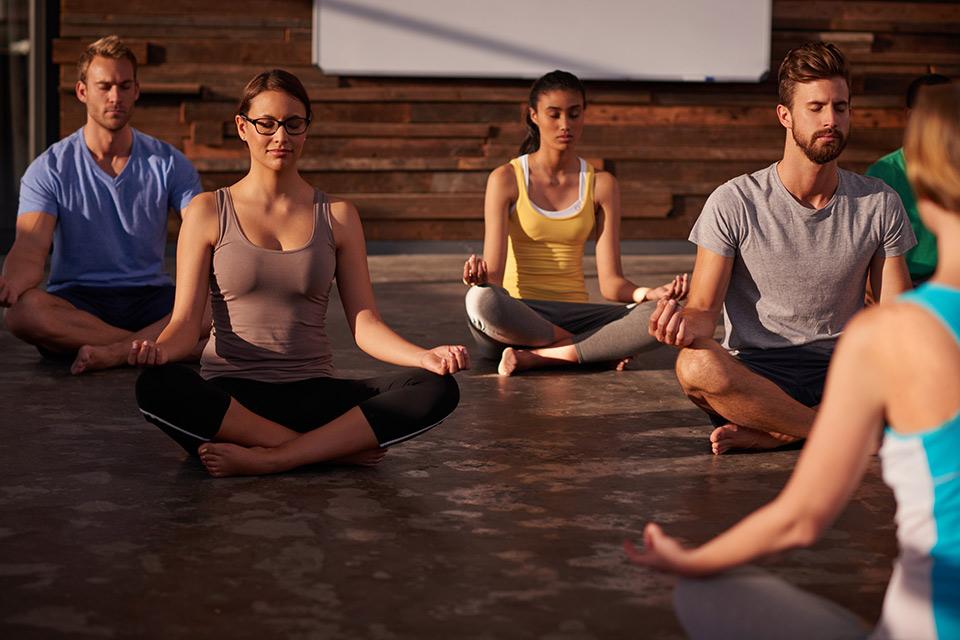Starting yoga might sound scary if you’re new to this activity. The poses may seem tough, and if you’re less “bendy,” you may find it hard to believe you could ever twist your body in this way. But if you’re able to push past this early fear and start practicing yoga, the payoff is well worth it. Find out the many mental and physical benefits of yoga, from stress reduction and weight loss to pain reduction and chronic disease management.

Yoga and stress
Yoga poses and breathing skills can help you react better to stress. When you feel worried and nervous, your body reacts by tensing your muscles. Your heart rate goes up and your breathing pattern changes. Over time, if your stress levels stay high, your stress hormones will raise both blood sugar levels and blood pressure. Yoga works to change the way your body reacts to stress. It’s been shown to help with mood, sleep and total well-being.
Yoga and weight loss
The best yoga classes for losing weight are Vigorous Power, Vinyasa and Ashtanga. In these classes, you change quickly between poses, which keeps your heart rate up. If you’re less able to move around or are new to yoga, there’s still good news. Doing yoga poses at a slower pace while using the breathing techniques is still very good for you! It helps you tune into your body, so you can recognize bad habits, such as emotional or mindless eating. Correcting these habits can also lead to weight loss.
Yoga and pain
By helping you relax into poses and focus your breathing, yoga has been shown to decrease pain. It calms both your muscles and your mind, helping your body turn off pain and start fixing itself. Even if you have chronic pain, doing yoga can help you feel better now — and in the long run. (Safety note: Be sure to move from one pose to the next slowly. Changing between poses too quickly can lead to injury and more pain.)
Yoga and diabetes
If you have diabetes, yoga can help you control your blood sugar level. It can also help with pain and numbness caused by nerve injuries due to diabetes. Studies show that people with type 2 diabetes who did yoga for 40 minutes a day had lower fasting blood sugar levels. And people in the same study had less numbness from nerve injuries. Another benefit the study found was improved breathing, shown by a 10% increase in lung size.
Getting started
You can start yoga at home or in a class setting. But make sure to start slowly. And stop right away if you feel pain or dizziness. Whether you focus on the breathing techniques or choose to do the physical movements as well, yoga will help make you healthier.
Do-it-yourself yoga basics
The key thing to keep in mind when starting yoga is that you should listen to your body and do what feels good to you. Here are a few steps to get started:
- Learn yoga breathing.
The basic yoga breath is to breathe in and out through your nose slowly. You should feel the breath expand in your belly each time. It’s common for beginners to find that they forget to breathe when they do yoga poses, so make sure you practice! - Try out basic poses.
Seated twist: Sit with your legs out in front of you. Cross your left leg over your right, putting your left foot flat on the floor close to your right knee. Wrap your right arm around the left knee and gently pull your knee toward your chest. Try to sit up straight. Breathe in and twist, looking over your left shoulder to the back wall. Hold for five breaths. Switch legs and repeat on the other side.
Cat pose: Get on your hands and knees. Breathe out and tuck your tail bone, rounding your back up. Let your head drop down. Press down into your hands. Breathe in and out for five breaths. Release your spine to the starting position. - End in a relaxation pose.
Rest on your back and relax all the muscles in your body for five to 15 minutes.
Yoga poses may feel weird at first, but this feeling will pass, and you’ll start to feel the positive changes in your body.
